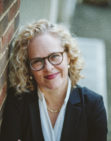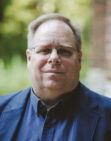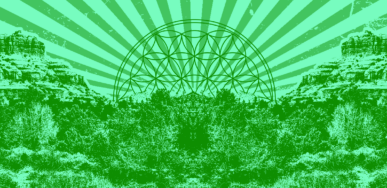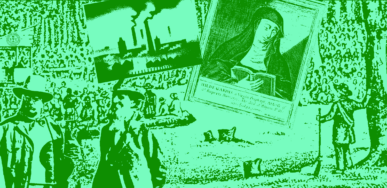Season 4, Episode 4: To Make the Desert Bloom
Kurtis Schaeffer [00:00:00] I'm Kurtis Schaeffer.
Martien Halvorson-Taylor [00:00:01] And I'm Martin Halverson. Taylor. And this is Sacred and Profane.
Kurtis Schaeffer [00:00:07] If you're new to the show, this episode is part of our ongoing series on climate change and religions in the United States. We call it Between Heaven and Earth. And the big question we're looking at is how religion has shaped the way Americans think about and live on the land and how the land has shaped religion.
Martien Halvorson-Taylor [00:00:27] Today's show starts with a man in search of a very particular kind of land.
Kathleen Flake [00:00:33] What Brigham Young wants is a place that no one else wants.
Kurtis Schaeffer [00:00:44] That's our colleague, Kathleen Flake. She's chair of Mormon studies here at the University of Virginia.
Brigham Young had become leader of the Latter day Saints after the group had been violently pushed out of settlements in New York, Ohio, Missouri and Illinois. The church's founder, Joseph Smith, had been arrested in the small town of Carthage, Illinois. Smith was then killed by a mob that stormed the jail.
Kathleen Flake [00:01:12] At that point there on the banks of the Mississippi River, they have established yet another colony only to be run out by mobs. And so they're looking to live anywhere where there are Americans who can gather enough political power to to do again to them what had been done in so many places.
Martien Halvorson-Taylor [00:01:37] What Young was looking for was a place that he believed other Americans would find so inhospitable they wouldn't follow.
Kathleen Flake [00:01:46] One of the more interesting documents from this history is there debates between 1844 when Smith was murdered in 1846, when they finally are forced to leave. They were looking at California. They were negotiating with Sam Houston in Texas. They were looking at a number of places outside the jurisdiction of the United States, people with whom they could affiliate and create political alliances with for protection against the United States. You hear comments by individuals in these meetings there having many of whom are coming from the British Isles. And so their idea of what land is supposed to look like is very different from where we know they're heading. And one of them, one says that he preferred Northern California because he's not much for sand.
Martien Halvorson-Taylor [00:02:32] But Brigham Young wanted sand.
Kathleen Flake [00:02:36] So they go out into the wilderness as they cross the plains looking for a place in which to build Zion. He wants a place that's so rough. And he will say this, that he can make saints out of people and and get enough time and shelter that he can build this kingdom. They wanted a society that completely integrated their religious lives, their political lives, their moral lives. And so he's looking for that place, and he finds it in the Great Basin, which is the western shelf of the Rockies. That expanse of territory between that and the and the mountains, that boundary and California. And they get to this place where their prophet says this is the right place. We're stopping here. Sorry to all you English people. We're stopping here. We're going to eat sand.
Martien Halvorson-Taylor [00:03:37] Brigham Young and his followers believed they were fulfilling a biblical prophecy by creating a new Zion. They were especially taken by the Book of Isaiah, which envisions as the King James version has it, “the wilderness and the solitary place shall be glad for them, and the desert shall rejoice and blossom as the rose.”
Kathleen Flake [00:03:59] They see their future in Isaiah. They see themselves as the realization of those prophecies.
Martien Halvorson-Taylor [00:04:06] That is to say, the church and its followers would bloom and multiply in the desert.
Kathleen Flake [00:04:12] What they expect is to be a generative people, to be to create life. That their understanding of the divine is that being who has the capacity to engender in others the quality of life that God has. Latter Day Saints are famous for their belief in families and reproduction and that the commitment to eternal families that these family bonds are not simply temporal, but they have salvific significance. So that's what we mean with the earth to the earth to has salvific significance. And their stewardship with respect to it is to bring forth the generative body of the earth from our day Saints. The world is shot through with the spirit. The material world is not inert. It is. It, too, is capable of this kind of this progressive quality that they identify with generative.
Kurtis Schaeffer [00:05:12] It is also clear that to create the kind of kingdom they dreamed up, Mormon settlers would have to transform the landscape around them to make the desert bloom more literally. Young had scouts sent ahead and they reached the Salt Lake Valley on July 22nd, 1847. By noon of the next day, they had planted a field of potatoes and by 2 p.m. they had dammed a creek to irrigate them.
Matt Lindon [00:05:41] Once you get past west of the hundredth meridian. Now, you can't grow anything without irrigating it.
Martien Halvorson-Taylor [00:05:51] That's Matt Lindon. He’s spent a lot of time thinking about water in Utah.
Matt Lindon [00:05:55] My name is Matt Lindon.I’m a hydrologist, a civil engineer and a hydrologist. I worked with the state of Utah for 25 years, mostly with dam safety and river restoration, and finished my last five years as the assistant state engineer for the state of Utah.
And so the first thing they did, the first thing they did when they came to the Salt Lake Valley was build little dams and irrigation check structures so they could start to plant crops right away and in the middle of July to sustain them for their at least their first year.
Martien Halvorson-Taylor [00:06:31] Matt says that while that first dam is long gone, it would have a huge impact across the Great Basin. For one thing, that creek, now known as City Creek, still supplies drinking water to Salt Lake City today. But it also proved that surface irrigation worked. And by the turn of the 20th century, settlers across the Great Basin had irrigated 6 million acres of productive farm and ranch land.
Kathleen Flake [00:07:02] So it's an extraordinary environmental project. It's hard for us living outside of that region to appreciate what water means. But it was life or death. As the population grew, it required more water resources, which means you had to go to more technologically sophisticated means of capturing and retaining water, and they would have water masters that then would direct the water and apportion it, and they would collectively agree how to do that.
Kurtis Schaeffer [00:07:36] In the first years after Brigham Young and his followers arrived, the church appointed water masters who controlled and distributed water rights to its members. As settlements grew, state and local governments would take over those projects. Secular authorities maintained not just the infrastructure, but also the system of water rights that the first settlers had put in place.
Matt Lindon [00:07:59] When they first came here, of course, it was all all just the Mormon Church and the Mormon Church divvied up the water rights, but it fairly quickly came to more of a governmental process. Not to say that the church wasn't involved, but. First tentative water right is “first in time, first in right.” So you had 100 acres. You want to grow 100 acres worth of alfalfa. You know, you could apply for an appropriation of that water. And that water right would be yours in perpetuity, and you would have a priority date and you would get your water first. And so that's the basis for the in the first in time, first in right philosophy that the people with the oldest water rights had the highest priority, had the most valuable water rights. The second part of it, and almost more important for us these days was that you had your water right. And you had to use that water or you would lose that water right.. You had to put it to beneficial use and keep putting it to beneficial use. And so there was no incentive for conservation, for efficiency. You had your water, you're going to use all your water. You don't want to lose your water.
Martien Halvorson-Taylor [00:09:07] Matt says those two rules: “first come, first serve,” and "use it or lose it” make a lot of sense when you look at the hydrology of the Salt Lake Valley. Most of the valley's water comes from snowmelt in the mountains above, and it ends up in the Great Salt Lake on the valley floor.
Matt Lindon [00:09:25] And if you can imagine, you know what, when they came into the valley, the valley was generally pretty dry except for the stream channels coming into the valley, which were probably pretty verdant, covered with cottonwood trees and willows and coming together probably somewhere around Liberty Park. But then eventually washing out to the Great Salt Lake and turning into salt water again, useless salt water. So they realized they've got to catch as much of this above the Great Salt Lake so that they could put it to beneficial use.
Kathleen Flake [00:09:55] They adapted to the environment and and the thing that was going to control this environment and them with it was going to be access to water and their ability to grow their society, which they intended to grow because they were gathering Israel from around the world. This was their mission and they were gathering to a place that had limited resources. So they had to figure out how to manage those resources and to to develop them, which of course, could lead us to a conversation of what's going on today.
PBS Newshour [00:10:27] The Great Salt Lake in Utah is the largest body of salt water in the Western Hemisphere without an outlet to the sea. An ongoing mega drought made worse by climate change means less precipitation and a growing population is taking more water before the lake can refill. Scientists say the resulting record low water levels in recent years are worrying.
Kurtis Schaeffer [00:10:49] There are three major factors shrinking in the lake. Climate change means there is often less water in the snowpack above the valley. Higher temperatures also means more evaporation from the lake itself. The third issue is the idea that water needs to be put to use.
Matt Lindon [00:11:07] And in the old times they used to think of water conservation was using all of it up. That's been the philosophy for a long time, almost up into modern times. Now we've prevented so much water from going to the Great Salt Lake. The Great Salt Lake is drying up and they realize that that could be that can be quite a problem, too, if if that dries up and turns into, you know, a desert playa with with with toxic chemicals and and prevailing winds, it could create a kind of a firestorm of toxicity blowing into the Great Salt Lake. So they're starting to see different uses for for rivers and for water besides just growing as many crops and as many people as as you possibly can. And they're starting to turn their focus more towards a natural natural stream environment and the public welfare.
Martien Halvorson-Taylor [00:11:59] While the Church of Latter Day Saints no longer controls how water is apportioned in Utah, that doesn't mean the church doesn't have influence in water politics.
Matt Lindon [00:12:09] You know, the Mormons have, of course, developed the valley here and developed water and developed the water rights. And eventually it became a states rights thing that was ostensibly separated from the Mormon Church. But realistically, you know, the Mormon Church has has great political influence in this state and therefore has has great political influence over water and the water rights. Though the state legislature is, I think, 75, 80% Mormon and they make the rules. You know, of course, like anything, it's going to be religion, it's going to be politics, and it's going to be about money.
Martien Halvorson-Taylor [00:12:47] The Mormon Church is one of the five largest landholders in the United States, controlling hundreds of thousands of acres of irrigated farmland across the country. And some of those acres are in Utah.
FOX 13 News Utah [00:13:02] The Church of Jesus Christ of Latter day Saints says it's exploring more ways to help the Great Salt Lake. In an interview with Fox 13 News political reporter Ben Winslow, a high ranking church official outlined what they're planning next.
Kurtis Schaeffer [00:13:17] In March 2023, Bishop Christopher Waddell made the announcement that the LDS church would be gifting some of the water rights it still holds in Utah to sustain the Great Salt Lake in perpetuity.
Bishop Christopher Waddell [00:13:30] We're grateful that that this effort, working with the state, will allow that water to be saved in perpetuity. That was a significant aspect of that donation. Wanted to make sure that it would be able to continue that wouldn't be used for other things in the future. The sheriff's do provide approximately 20,000 acre feet, which is the equivalent of the amount of water to 20,000 single family home connections.
Kurtis Schaeffer [00:13:52] That is a lot of water, but only around 2% of what experts say is needed to restore the Salt Lake.
Kathleen Flake [00:14:01] The church is in an interesting position. Many people complain about its status — political, economic, cultural in the state. And at the same time they rely upon it for a kind of aid that they can't seem to get out of their political system. So I thought they were very careful to acknowledge their responsibility, but show the problem of the Great Salt Lake is not within the power of the church to fix.
Bishop Waddell [00:14:38] As the church strives to reduce its water use. We invite members of the church and community to also reduce their consumption. We encourage engagement and responsiveness to legislative changes and other recommendations from subject matter experts. Recognizing the need to act with urgency and unity towards the future, we hope for one with a healthy, great Salt Lake. I echo the invitation given last June for all to pray and fast for rain and respite from a devastating drought and for inspiration to know how we can each individually contribute to a resolution of this difficult issue.
Kathleen Flake [00:15:14] There's a subtle message in there, and that goes something like, they acknowledge that they colonized this territory and they trace the history of that colonization in part to say we no longer have that kind of control over this territory. So this is what we're trying to do with the control we do have over our properties, our business usages, our ecclesiastical properties, etc., etc.. But by and large, Utah's land is no longer under our control. They're trying to be an example of what they think other people need to be doing. And they're making it clear that they are giving resources to the state. And to the extent that agricultural water is the main problem with the Great Salt Lake. The water does flow towards money. It flows towards agricultural money in Utah. And that's that's where some of the hard thinking and hard politics have to occur.
Martien Halvorson-Taylor [00:16:29] There's an old saying in the American West. Water flows uphill towards money. But it might also be possible for political clout to let it flow downhill again into the lake. It's impossible to say if the church's backing will unlock enough water from Utah's irrigated fields to save the Great Salt Lake. But it seems clear that just as it has from the beginning, the LDS Church has a central role to play in water politics in the Salt Lake Valley. After all, Matt Lindon told us, politics are just another part of the water cycle in the Anthropocene.
Matt Lindon [00:17:12] The hydrologic cycle. Just the basis of it. Water magically evaporates upward and we get this continual supply of of clean, fresh water, you know, all across the world. That's just an amazing thing. And that is the old cycle. I think the new hydrologic cycle is you a water is related to energy, is to money, to people and to politics. And, you know, those are the circles that we go in and out.
Kurtis Schaeffer [00:17:58] Sacred & Profane was produced for the Religion, Race and Democracy lab at the University of Virginia. This episode was made possible by a grant from the National Endowment for the Humanities. Our senior producer is Emily Gadek. Our guests were Kathleen Flake and Matthew Lindon.
Martien Halvorson-Taylor [00:18:17] Music for this episode comes from Blue Dot Sessions. You can find out more about our work at Religion lab.virginia.edu.
Brigham Young lead his followers west in 1846, fleeing religious persecution. Young was looking for a place that his fellow Americans would consider too inhospitable to follow — a place that would transform believers into a new people, where they could “blossom as the rose.”
But it was also clear as much as the desert would transform the church, the church would have to transform the desert. Only hours after scouts arrived in the Salt Lake Valley, they built a dam and irrigated a field of potatoes. And as church settlements spread across the Great Basin, green fields and lawns followed — practices that were also eagerly embraced by non-L.D.S settlers who followed.
Their success in making the desert bloom has come at a cost. As demands on water grow and climate change makes weather more erratic, the Great Salt Lake is retreating, exposing toxic salts and threatening the reliable snowfall that still provides much of the region’s water.
We are joined by guests Kathleen Flake and Matt Lindon to discuss the growing water crisis in the Salt Lake Valley — as well as the role that the Church of Latter Day Saints has to play in efforts to let the Great Salt Lake thrive in a warmer, drier West.
Additional Credits
Special thanks to Erin Burke, Rebecca Bultman, and Devin Zuckerman for their help on this episode.






